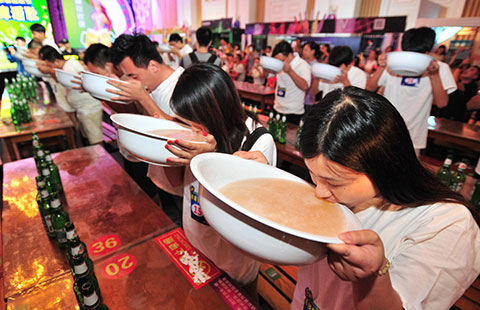Death and glory in the mountains
By Zhao Xu (China Daily) Updated: 2015-04-22 07:41
|
A gas mask Yang discovered suggests the Japanese used poison gas during their invasion. Photo by Zou Hong / China Daily |
A dramatic discovery
For many people, the war is just a distant memory, but the village and surrounding countryside hold a fascination for Yang, who grew up in the vicinity and knows the area like the back of his hand.
His obsession with the battle began with a dramatic discovery in 2005, when he was 42. "At the time I was working as a guide for a local mountaineering club. One day, as we were camping on a mountain called Gaolou or 'High-rise', I suddenly spotted an ancient fire tower pitted with bullet holes," he said. "This was at the highest point of the Beijing section of the Great Wall, 1,400 meters above sea level. No one, no thing, could have punched holes in that thick stone wall except bullets fired from a powerful machine gun."
Yang returned a year later, after studying the county records and talking with many elders in the neighboring villages. This time, though, he was accompanied by a few friends and a metal detector.
"Treasure hunters will know how excited we all felt," Yang said. "I remember the first time the detector bleeped, I shouted 'get down' to the others and threw myself on the ground, just in case it was an unexploded bomb or landmine. Later, we got up and started digging, eventually discovering an acid-eaten cartridge case. We were elated, but I had absolutely no idea what was to come - all the heavy things that were about to inundate my mind," he said.
As Yang dug deeper and looked more closely, he discovered a cache of wartime debris. "The stuff was everywhere, cartridges and fragments of bullets and rusted cannons, all separated from us by almost 80 years and a thin layer of soil," he said. "There are bomb craters and small trenches hidden under the bushes. That's where the Chinese soldiers fired as the Japanese charged up the slope."
Yang's quest for history hit a mournful and disturbing note in November 2011, when he spent a night on a snow-covered mountain beside a deep ravine the locals call "The Valley of the Dead". "At one time, the land was strewn with bodies from the fighting. They were later washed down into the valley below by torrential rain," Yang said. "The locals believed the valley was haunted. I decided to spend a night there - not to test the rumor, but to be closer to the war."
Despite his resolve, Yang was terrified when he heard a loud rustling sound shortly after sunset. He stayed awake until the early hours, occasionally venturing from his tent. "When I awoke, the sun was high in the sky, and I discovered boar bristles on the tree trunks just a few steps from my tent. I had gotten myself in the way of a wild boar that had impatiently rubbed itself against the tree," he said.
"The wind was vicious at midnight, scooping up the snow and making every tree branch squeal. It died down later, though, and gave way to an all-encompassing stillness in which the sound of a single leaf falling to the ground was distinctly audible," Yang said. "For me, it was like a replay of the battle - its heated hours and its aftermath."
Yang said the memory is indelible, but not as harrowing as an experience that involved garlic rather than ghosts. "As I dug deeper, I found an iron shovel, and then a teacup and a bowl, both with porcelain enamel. The cup was used to cover the bowl. I opened it gingerly and there it was, a garlic bulb whose inside had rotten away but whose outside was still intact," he said. "Initially, I thought it might have been dropped there by someone, maybe a few years ago. But as I removed the items and dug again with my spade, I discovered a belt buckle, a bullet clip and a tube of toothpaste with Chinese characters that said it had been produced by a manufacturer in Shanghai in the 1930s. All of these things were lying on top of an unused gas mask.
"The Chinese soldiers probably died suddenly while resting in this area away from the main battlefield, overpowered by deadly gunfire, or more likely, by a cloud of the poison gas the Japanese used," he said. "Like a still life painting, those everyday items offered a poignant reminder of the cruelty of war."
Today, the teacup, bowl and gas mask share the same shelf in Yang's small underground museum below his family's tiny shop. "Each shelf is dedicated to a different part of the battleground," he said, scanning his collection of nearly 2,000 items, including cartridges, helmets, hat badges, and in one case, a few shards of bone wrapped in cloth and sealed in a small box. "It's an addiction. Not going there for a few days would be hard for me because I feel those who died there are calling to me, and their stories are still waiting to be told."
- Govt encourages people to work 4.5 days a week
- Action to be taken as HIV cases among students rise
- Debate grows over reproductive rights
- Country's first bishop ordained in 3 years
- China builds Tibetan Buddhism academy in Chengdu
- Authorities require reporting of HIV infections at schools
- Typhoon Soudelor kills 14 in East China
- Police crack down on overseas gambling site
- Debate over death penalty for child traffickers goes on
- Beijing to tighten mail security for war anniversary








